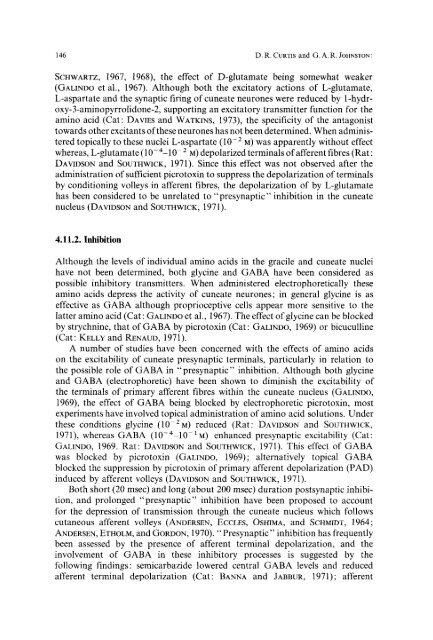Amino acid transmitters in the mammalian central nervous system
Amino acid transmitters in the mammalian central nervous system
Amino acid transmitters in the mammalian central nervous system
You also want an ePaper? Increase the reach of your titles
YUMPU automatically turns print PDFs into web optimized ePapers that Google loves.
146 D.R. CURTIS and G. A. R. JOHNSTON :<br />
SCHWARTZ, 1967, 1968), <strong>the</strong> effect of D-glutamate be<strong>in</strong>g somewhat weaker<br />
(GALINDO et al., 1967). Although both <strong>the</strong> excitatory actions of L-glutamate,<br />
L-aspartate and <strong>the</strong> synaptic fir<strong>in</strong>g of cuneate neurones were reduced by 1-hydroxy-3-am<strong>in</strong>opyrrolidone-2,<br />
support<strong>in</strong>g an excitatory transmitter function for <strong>the</strong><br />
am<strong>in</strong>o <strong>acid</strong> (Cat: DAVIES and WATKINS, 1973), <strong>the</strong> specificity of <strong>the</strong> antagonist<br />
towards o<strong>the</strong>r excitants of <strong>the</strong>se neurones has not been determ<strong>in</strong>ed. When adm<strong>in</strong>istered<br />
topically to <strong>the</strong>se nuclei L-aspartate (10-2 M) was apparently without effect<br />
whereas, L-glutamate (10- 4-10 2 M) depolarized term<strong>in</strong>als of afferent fibres (Rat:<br />
DAVIDSON and SOVTHWICK, 1971). S<strong>in</strong>ce this effect was not observed after <strong>the</strong><br />
adm<strong>in</strong>istration of sufficient picrotox<strong>in</strong> to suppress <strong>the</strong> depolarization of term<strong>in</strong>als<br />
by condition<strong>in</strong>g volleys <strong>in</strong> afferent fibres, <strong>the</strong> depolarization of by L-glutamate<br />
has been considered to be unrelated to "presynaptic" <strong>in</strong>hibition <strong>in</strong> <strong>the</strong> cuneate<br />
nucleus (DAVIDSON and SOUTHWICK, 1971).<br />
4.11.2. Inhibition<br />
Although <strong>the</strong> levels of <strong>in</strong>dividual am<strong>in</strong>o <strong>acid</strong>s <strong>in</strong> <strong>the</strong> gracile and cuneate nuclei<br />
have not been determ<strong>in</strong>ed, both glyc<strong>in</strong>e and GABA have been considered as<br />
possible <strong>in</strong>hibitory <strong>transmitters</strong>. When adm<strong>in</strong>istered electrophoretically <strong>the</strong>se<br />
am<strong>in</strong>o <strong>acid</strong>s depress <strong>the</strong> activity of cuneate neurones; <strong>in</strong> general glyc<strong>in</strong>e is as<br />
effective as GABA although proprioceptive cells appear more sensitive to <strong>the</strong><br />
latter am<strong>in</strong>o <strong>acid</strong> (Cat: GALINOO et al., 1967). The effect ofglyc<strong>in</strong>e can be blocked<br />
by strychn<strong>in</strong>e, that of GABA by picrotox<strong>in</strong> (Cat: GALINOO, 1969) or bicucull<strong>in</strong>e<br />
(Cat: KELLY and RENAUD, 1971).<br />
A number of studies have been concerned with <strong>the</strong> effects of am<strong>in</strong>o <strong>acid</strong>s<br />
on <strong>the</strong> excitability of cuneate presynaptic term<strong>in</strong>als, particularly <strong>in</strong> relation to<br />
<strong>the</strong> possible role of GABA <strong>in</strong> "presynaptic" <strong>in</strong>hibition. Although both glyc<strong>in</strong>e<br />
and GABA (electrophoretic) have been shown to dim<strong>in</strong>ish <strong>the</strong> excitability of<br />
<strong>the</strong> term<strong>in</strong>als of primary afferent fibres with<strong>in</strong> <strong>the</strong> cuneate nucleus (GALINDO,<br />
1969), <strong>the</strong> effect of GABA be<strong>in</strong>g blocked by electrophoretic picrotox<strong>in</strong>, most<br />
experiments have <strong>in</strong>volved topical adm<strong>in</strong>istration of am<strong>in</strong>o <strong>acid</strong> solutions. Under<br />
<strong>the</strong>se conditions glyc<strong>in</strong>e (10- 2 M) reduced (Rat: DAVIDSON and SOUTHWICK,<br />
1971), whereas GABA (10 -4 10 1M) enhanced presynaptic excitability (Cat:<br />
GALINDO, 1969. Rat: DAVIDSON and SOUTHWICK, 1971). This effect of GABA<br />
was blocked by picrotox<strong>in</strong> (GALINDO, t969); alternatively topical GABA<br />
blocked <strong>the</strong> suppression by picrotox<strong>in</strong> of primary afferent depolarization (PAD)<br />
<strong>in</strong>duced by afferent volleys (DAvIDSON and SOUTHWlCK, 1971).<br />
Both short (20 msec) and long (about 200 msec) duration postsynaptic <strong>in</strong>hibition,<br />
and prolonged "presynaptic" <strong>in</strong>hibition have been proposed to account<br />
for <strong>the</strong> depression of transmission through <strong>the</strong> cuneate nucleus which follows<br />
cutaneous afferent volleys (ANDERSEN, ECCLES, OSHIMA, and SCHMIDT, 1964;<br />
ANOERSEN, ETr~OLM, and GORDON, 1970). "Presynaptic" <strong>in</strong>hibition has frequently<br />
been assessed by <strong>the</strong> presence of afferent term<strong>in</strong>al depolarization, and <strong>the</strong><br />
<strong>in</strong>volvement of GABA <strong>in</strong> <strong>the</strong>se <strong>in</strong>hibitory processes is suggested by <strong>the</strong><br />
follow<strong>in</strong>g f<strong>in</strong>d<strong>in</strong>gs: semicarbazide lowered <strong>central</strong> GABA levels and reduced<br />
afferent term<strong>in</strong>al depolarization (Cat: BANNA and JABBUR, 1971); afferent













